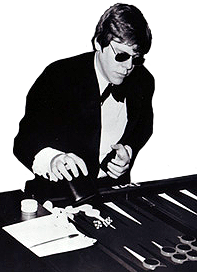|
| Magriel's NYT Columns |

|
About the Column Beginning today, The Home Section of The New York Times will carry a regular column on backgammon, written by Paul Magriel, one of the world’s top-rated backgammon theoreticians and players. The column will provide news coverage of major tournaments and other developments in the game, which is played by millions of people in America and around the world. Good backgammon players rely on skill and strategic sophistication rather than luck, and the column will offer thematic analysis of the underlying principles of the game, often with positions taken from actual tournament play. The column will be written in direct, nontechinical language understandable not just by advanced players, but also by anyone who has a basic familiarity with the game. |
* * *
The annual spring tournament at the Clermont Club in London is one of Europe’s major backgammon events. The tournament always attracts strong players from all over the world, for the stiff competition and the substantial prize money offered by the club. Stephen Raphael, long considered the dean of British backgammon players, won the tournament, defeating Brian Gilbert 21–13 in the finals. In the course of the match, Raphael gave an example of what is known as a tempo play — where one hits for the purpose of creating a momentary distraction.
|
| Black to play 5-4. |
In the diagrammed position, Black, Raphael, correctly plays 24/20, 6/1*, splitting his back runners with a 4 to the 20-point, and hitting on the 1-point with a 5.
The key question is, why does Black hit on the 1-point? The usual reasons for hitting can be dismissed here. Clearly, there is little hope that White, Gilbert, will stay out. Also, Black hardly gains at all in the race by hitting — in fact, if White reenters with a 1, hitting Black, Black will lose considerable ground. Furthermore, even if White should miss Black’s blot on the 1-point, it would be premature for Black to cover it. Making so deep a point in his home board would be a serious positional liability at this early stage in the game.
The logic of hitting on the 1-point depends on the other half of the play — splitting the back runners.
In the diagrammed position, Black has fallen behind in development; White already has three strong points in his home board and is well on his way toward trapping Black’s two back men. But Black can prevent them from being trapped by establishing a forward point in White’s home board, particularly the 20-point (White’s five point). Experts consider this point, the Golden Point, as the single most valuable point in the early stages of the game. In this position, if Black can make the Golden Point, he will turn a weak game into an easily defensible one.
However, as much as Black needs this point, he is reluctant to leave a single man exposed there. The danger is too great that White, with a full roll, will make a point on Black, or failing that, will hit both of Black’s back men. Hitting on the 1-point is Black’s solution to this problem.
The hit serves to protect the man Black has split to the 20-point. By diverting White, Black greatly increases his chance of establishing the Golden Point. Since White must use half his roll to reenter, White cannot make the 20-point — except by rolling doubles. At best, with his remaining half roll, he can hit “loose” (unprotected) there, leaving himself exposed to many direct shots. Besides, even if White hits Black on the 1-point, this may only increase the number of ways for Black to establish the 20-point when Black reenters. Possession of the Golden Point will more than compensate for having an additional man sent back.
Rollout
 Tom Keith 2013 |
|
Money play Centered cube Black rolls 5-4 1296 games with VR Checker play: 2-ply Cube play: 3-ply Red |
| 5-4: | Game | G | BG | Equity | ||||
| 1 | 13/9, 6/1* |
W L |
.3574 .6426 |
.0922 .2336 |
.0037 .0200 | −0.6595 |

| |
| 2 | 9/4, 8/4 |
W L |
.3490 .6510 |
.1024 .2335 |
.0040 .0217 | −0.6726 | (0.0131) | |
| 3 | 24/20, 6/1* |
W L |
.3647 .6353 |
.0906 .2914 |
.0047 .0167 | −0.6816 | (0.0221) | (a) |

|
